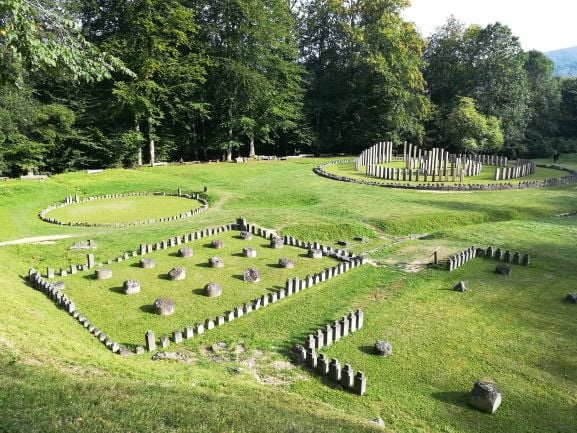Sarmizegetusa Regia, the second Dacian capital, as historians say, is the biggest settlement known in Dacia. It is part of the complex of six Dacian fortifications: Sarmizegetusa Regia, Costești-Cetățuie, Costești-Blidaru, Luncani-Piatra Roșie, Bănița and Căpâlna.



The Capital of the Dacian Kingdom
Sarmizegetusa Regia started being the capital of the Dacian kingdom starting with the second half of the first century before Christ. For the next 150 years, Sarmizegetusa Regia acted as a political, religious, military and economic centre of Dacia.
As you climb towards the fortress, most of the hills that can be seen have been terraformed so that they could be habitable. The specialists call the areas the East and West civil wings. Sarmizegetusa Regia added up to 4.5km and was formed from three major parts: the sacred area, the East and West civil wings and the fortification.






The Ruins of Sarmizegetusa Regia
What can be seen today are the ruins of a fortification that dates back to the start of the second century, during the wars between Dacians and Romans. The interior surface is around 30.000 metres squared and is walled by blocks of chalk and andesite.
According to the official site, https://cetateasarmizegetusa.ro, belonging to the Public Service of Historical Monuments Administration, the fortress was much smaller. It was only a third of its final area, however, it would soon suffer changes rearrangements during the wars.









A 200-metre path of chalk slabs was connecting the fortification and the sacred area. Here, the Dacians have built walls of chalk that reach 10 metres in height. The sacred area from Sarmizegetusa Regia, is composed of seven temples, two of which are circular while the others are quadrilateral. There was also one main altar and a water distribution network.






Religious constructions and crafting workshops
One would imagine there would only be religious constructions, however, the historians say that there have been homes and crafting workshops. Thousands of iron pieces have been found: agriculture tools, jewels, decorative and household objects as well.
The first written information about the fortification comes from a medieval source (“Chronika az magyaroknac dolgairól” -Gáspár Heltai, Cluj, 1575) which mentions its location..
The authorities reacted only during the 19th century after locals started to find many gold coins. The fiscal domain prosecutor, Paul Török, later finds the ruins after going to Grădiştea de Munte. The first diggings were done between 1803-1804. These uncover one of the circular temples, the pentagonal tower and the roman bath. However, the first archeologic campaign takes place in 1922, after the Great Union.
Sarmizegetusa Regia the most important city of ancient Dacia
The research demonstrated that Grădiştea de Munte occupies a central position while the other citadels surround it for protection. The historians say the Dacians have arranged over 260 terraces.






The majority of them were built on the South-Eastern side of the hill.
With the help of Constantin Daicoviciu, who led the second biggest archaeology project, the fortifications, temples, workshops and water distribution systems that were found made Sarmizegetusa Regia the most important city of ancient Dacia.
You should not miss visiting the other Dacian capital Ulpia Traiana Sarmizegetusa Augusta
You should not miss visiting the Dacian capital without a doubt. Some tourists claim that among the ruins of Sarmizegetusa Regia there are certain energies that help us rediscover our vitality.
For a better understanding, however, we invite you in the Western part of Hunedoara county and visit the second capital of the Dacian province, Ulpia Traiana Sarmizegetusa Augusta. With this occasion, you will have the occasion to uncover the story which is the basis for the Romanian civilisation.
We also recommend:



